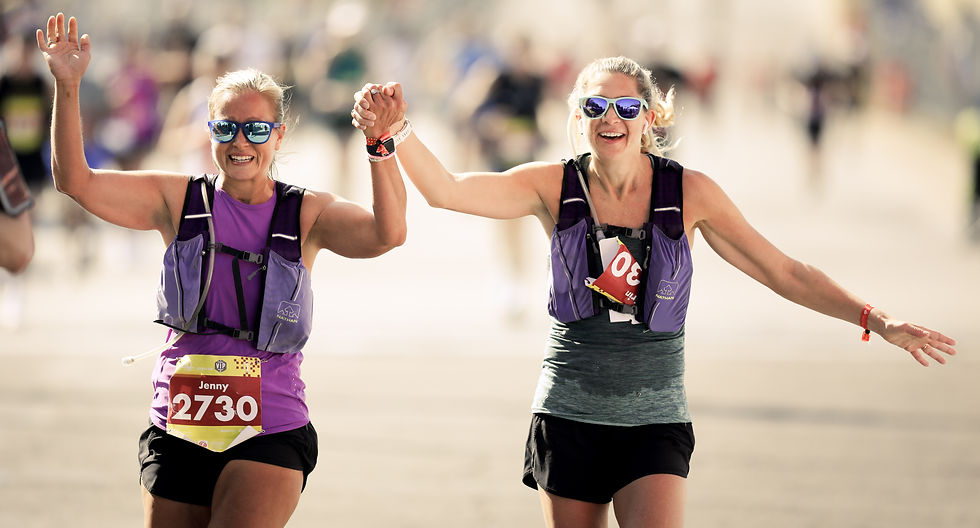Race Fueling for the 10 Mile and Half Marathon
- charlie4243
- Aug 11
- 3 min read
Updated: Aug 12

When you're lining up for the 10 mile or half marathon at the Medtronic Twin Cities Marathon Weekend, having a solid fueling plan can help you feel strong from start to finish. Whether you're aiming to set a personal best or simply enjoy the race, here’s how to fuel and hydrate for success, plus what to expect on the course.
A Few Days Before the Race
Be intentional about your nutrition in the 1–2 days leading up to race day by including more carbohydrate-rich foods in your meals. Think pasta, rice, potatoes, bread, fruit, juice, or sports drinks. This helps top off your glycogen stores so your legs feel fresh when the race begins.
Want a deeper dive into how to carb load effectively (without overthinking it)? Grab this FREE Carb Loading Guide —perfect for runners tackling 10+ mile races.
Race Morning: Your Pre-Race Meal
Eat a familiar, carb-rich breakfast 2.5 to 3 hours before the race. This helps maintain blood sugar levels and gives you steady energy. Some easy options:
Bagel with peanut butter, banana and honey
Oatmeal with dried fruit
Toast with jam + applesauce
A sports drink if solid food is hard to tolerate
Plan to drink 16–20 oz of water or a sports drink during this time to hydrate.
Fueling During the Race
For the Half Marathon
Hydration: Water and Nuun Endurance are available every 2 miles through mile 9, then every mile to the finish.
Fuel: There is one gel station at mile 3.9. If you'll be running longer than 90 minutes, plan to take a gel or chews around this point—just like you’ve practiced.
Carbohydrates: Most runners benefit from at least 30–60 grams of carbs per hour, so consider continuing to fuel every 30–45 minutes as needed. Sticking with your usual routine helps keep energy steady and reduces the chance of stomach issues.
For the 10 Mile
Hydration: Water and Nuun Endurance are available starting at mile 3, then every 1–1.5 miles.
Fuel: No gels are available on course, so if you usually take fuel, bring your own. One gel or a few chews around mile 4–6 can help if your race will last longer than 75–90 minutes.
Carbohydrates: You may not need fuel if your race is under 75 minutes, but it can provide an edge, especially if you’re racing at a higher intensity.
Final Tips
Practice before race day. Don’t try anything new! Practice your pre-run breakfast and mid-run fueling strategy on long runs.
Carry what you need. Even with on-course options, bring your preferred fuel if you’re picky about flavors or have a sensitive stomach.
Adjust based on the weather. Warmer conditions = more sweat and more fluid/electrolyte needs.
(Running the marathon? Check out Kristy's marathon fueling advice here.)
Want Personalized Support?
If you're unsure how to fuel for your race, recover better, or just feel stronger in training, check out The Fueled Runner Club—my monthly membership where runners get support, fueling plans, and expert coaching to train smarter and feel more confident with food.
Fueling well isn’t just about carbs and gels—it’s about giving your body what it needs to show up strong on race day. You’ve trained for this—now let your fuel do the rest. Good luck out there! This article originally appeared in the The Connection, TCM's weekly e-newsletter. Subscribe here.
Photo by Ben Garvin.
(Disclaimer: The content in this blog is for educational purposes only and provides generalized nutrition guidance. For personalized recommendations, please consult your sports dietitian. Individuals who choose to implement nutrition changes agree that Kristy Baumann Nutrition, LLC is not responsible for any injury, damage or loss related to those changes or participation.)

Kristy Baumann, RD, LD, is a Registered Dietitian who specializes in working with runners. She is one of the team of Motion Experts TCM has gathered to help its subscribers and participants get the most out of their running. Have a question for Kristy: [email protected], Instagram: @marathon.nutritionist or website: marathonnutritionist.com.


